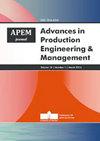将离散事件模拟作为一种有效的方法应用于回收材料的生产
IF 2.8
3区 工程技术
Q2 ENGINEERING, MANUFACTURING
引用次数: 8
摘要
工艺流程在企业生产系统中起着至关重要的作用。由于这些系统属于一组可能确定的结构,因此它们的行为和功能无法确定地预测。一般来说,如果我们想提前准确地知道这种情况的行为,我们就必须能够用数学方法描述它们,或者观察系统对真实物体的作用。通过应用离散事件仿真软件,我们实现了环保产品的开发,通过仿真,我们获得了在给定的时间框架内可以实现计划任务的确定性,而生产过程的仿真可以帮助我们清晰地阐明和更好地理解过程。为了选择从废轮胎中清洗织物组件的最佳制造方式,我们使用Witness离散事件模拟软件来确定新织物基材料生产中各个机器的可用性和时间占用。我们模拟了从废轮胎中清洗织物成分的超声波方法和随后的测试样品的创建。仿真后得到的数据可用于选择机器和辅助设备的类型和数量、工具和夹具的数量以及运输设备的数量。所获得的结果带来了最佳的工作场所布局,最优的投入材料和生产中使用的资源。我们已经确定了等待时间较长的机器的瓶颈。研究的重点是减少瓶颈,提高整个生产线的效率。本文章由计算机程序翻译,如有差异,请以英文原文为准。
Using a discrete event simulation as an effective method applied in the production of recycled material
Technological processes play an essential task in the enterprise's production system. The behaviour and functioning of these systems cannot be predicted with certainty as they belong to a group of probable determinate structures. Generally, if we wanted to know precisely the behaviour of this condition in advance, we would have to be able to describe them mathematically or observe the action of the system on a real object. By applying discrete event simulation software, we realize the development of environmentally friendly products and using the simulation, we gain the certainty that the planned tasks can be implemented in a given time frame, while the simulation of the production process can help to clearly clarify and better understand the processes. To choose the optimal manufacturing ways of cleaning the fabrics component from waste tyres, we used the Witness discrete event simulation software to determine the usability and time occupancy of individual machines in the production of new fabric-based material. We simulated the ultrasonic method of cleaning the fabrics component from waste tyres and the subsequent creation of the test specimen. After the simulation, the obtained data can be used by a selection of type and number of machines and auxiliary equipment, by numbers of tools and fixtures, and by numbers of transport equipment. Obtained results bring the best layout of the workplace, the optimal dose of input materials and resources used in production. We have identified bottlenecks in the machines with long waiting times. The research priority was to reduce bottlenecks and increase the effectiveness of the entire of production line.
求助全文
通过发布文献求助,成功后即可免费获取论文全文。
去求助
来源期刊

Advances in Production Engineering & Management
ENGINEERING, MANUFACTURINGMATERIALS SCIENC-MATERIALS SCIENCE, MULTIDISCIPLINARY
CiteScore
5.90
自引率
22.20%
发文量
19
期刊介绍:
Advances in Production Engineering & Management (APEM journal) is an interdisciplinary international academic journal published quarterly. The main goal of the APEM journal is to present original, high quality, theoretical and application-oriented research developments in all areas of production engineering and production management to a broad audience of academics and practitioners. In order to bridge the gap between theory and practice, applications based on advanced theory and case studies are particularly welcome. For theoretical papers, their originality and research contributions are the main factors in the evaluation process. General approaches, formalisms, algorithms or techniques should be illustrated with significant applications that demonstrate their applicability to real-world problems. Please note the APEM journal is not intended especially for studying problems in the finance, economics, business, and bank sectors even though the methodology in the paper is quality/project management oriented. Therefore, the papers should include a substantial level of engineering issues in the field of manufacturing engineering.
 求助内容:
求助内容: 应助结果提醒方式:
应助结果提醒方式:


